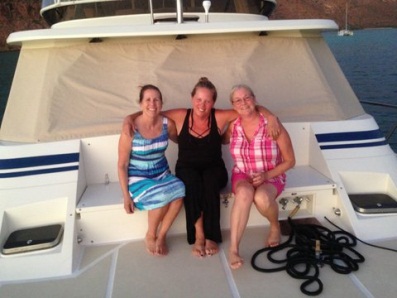Blog Post 24 – Espiritu Santo Natural Marine Park
12/11/15 – 12/23/15
24:24.14N – 110:11.41W
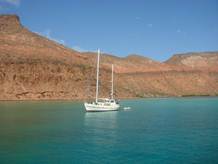
 In 2003 an alliance of Mexican and US conservation groups purchased this island chain to preserve and protect them. They consist of 3 islands, Espiritu Santo, Isla Partida and Los Islotes. Espiritu Santo is the largest at about and is 8 miles wide, Isla Partida is about 4 miles long and Los Islotes is basically a big rock. According to the Nature Conservancy who was very instrumental in purchasing the islands claims that the island chain is the 2nd most diverse marine body in the world. It is home to 31 species of whales and dolphins (1/3 of the world’s total). The region is also a breeding ground for sea lions and sea turtles and is home to and a migratory corridor for 210 bird species. There are 500 fish species, 4848 known species of macro invertebrates (whale food) and 626 forms of algae. These islands are only 27 miles from La Paz (just like going from LA to
In 2003 an alliance of Mexican and US conservation groups purchased this island chain to preserve and protect them. They consist of 3 islands, Espiritu Santo, Isla Partida and Los Islotes. Espiritu Santo is the largest at about and is 8 miles wide, Isla Partida is about 4 miles long and Los Islotes is basically a big rock. According to the Nature Conservancy who was very instrumental in purchasing the islands claims that the island chain is the 2nd most diverse marine body in the world. It is home to 31 species of whales and dolphins (1/3 of the world’s total). The region is also a breeding ground for sea lions and sea turtles and is home to and a migratory corridor for 210 bird species. There are 500 fish species, 4848 known species of macro invertebrates (whale food) and 626 forms of algae. These islands are only 27 miles from La Paz (just like going from LA to  Catalina) and are frequently visited by mariners staying in La Paz. They are a ‘must see’ if you are visiting the area.
Catalina) and are frequently visited by mariners staying in La Paz. They are a ‘must see’ if you are visiting the area.
Espiritu Santo has blade like ridges that jut out into the sea, making for some incredible anchorages. We headed out there with our cruising friends, Mark and Cindy from Delta Swizzler and Bill and Michelle from Adagio. The first cove we anchored at was Ensenada de La Raza which is part of Puerto Ballena (Whale Port) that is a 3 lobed bay with 2 smaller islands, Isla Gallo (Rooster Island) and Isla Gallina (Hen Island). The cove is known for its crystal clear turquoise waters and colorful striated cliff sides. The 2 small islands both have reefs that are perfect for snorkeling and diving. The inlets are very shallow at about 2-3 feet at high tide so you need to anchor pretty far out to be safe from running aground. You can kayak or dinghy ashore where there are trails leading up the cliffs 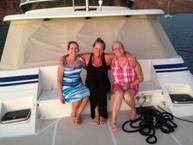 and over to the other side of the island. Ensenada Ruiz did not have much in the way of a beach and it is covered with mangrove tress and their accompanying swamps. In Mexico, mangrove trees = mosquitos. Nico and I kayaked ashore but did not want to tramp through the mangroves to get to the other side. As you approach the trees you can hear all the buzzing from the bugs. No thank you! Nico and I are both bug wimps and mosquitos just love me. Each night we would do a potluck on someones boat. The ladies organize it so we have a balanced meal. We usually ate on the other boats as they are 55+ft power boats with much more room to entertain than we have. We would eat drink and play games. During the day we swam and snorkeled.
and over to the other side of the island. Ensenada Ruiz did not have much in the way of a beach and it is covered with mangrove tress and their accompanying swamps. In Mexico, mangrove trees = mosquitos. Nico and I kayaked ashore but did not want to tramp through the mangroves to get to the other side. As you approach the trees you can hear all the buzzing from the bugs. No thank you! Nico and I are both bug wimps and mosquitos just love me. Each night we would do a potluck on someones boat. The ladies organize it so we have a balanced meal. We usually ate on the other boats as they are 55+ft power boats with much more room to entertain than we have. We would eat drink and play games. During the day we swam and snorkeled.
We wanted to anchor in as many coves as we could so we only stayed in La Raza for 2 nights. Then we headed about 2 miles north to Ensenada Candelera (Candlestick Cove). I liked this anchorage much better.  It had a huge rock with a reef jutting out right in the middle of the cove so we were able to snorkel right from the boat. There is something so cool to me about being able to don your snorkel gear and just jump off the boat into this incredible marine wonderland. At first I was a little nervous because I was afraid of big fish and keep thinking that a shark would swim up and scare the
It had a huge rock with a reef jutting out right in the middle of the cove so we were able to snorkel right from the boat. There is something so cool to me about being able to don your snorkel gear and just jump off the boat into this incredible marine wonderland. At first I was a little nervous because I was afraid of big fish and keep thinking that a shark would swim up and scare the  shit out of me. But we did not see any sharks at all in the five days were out in the islands.
shit out of me. But we did not see any sharks at all in the five days were out in the islands.
The beach at Candelera was much nicer. It was wide with a white sand beach and some very interesting rock formations made from volcanic activity. We got some great photos of the beach, the boat at anchor and the rocks. When our friends arrived they told us about a hike to a waterfall and a cave. That was a must do for me and Nico. Jirig hates to walk so he was not that excited about it. In his defense, I have on several occasions gotten the distance and difficulty of hikes screwed up so he has good reason to be skeptical. But being on an island that is only 8 miles long how far could it be? These rock formations have formed over millions of years to appear as they do today. The hike was only about a mile up the arroyo.
The weather was about to turn bad so we headed back to La Paz to prepare for Christmas and pick up Daniel from the airport.
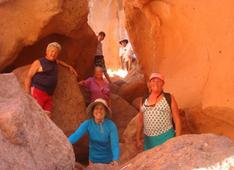 We headed back out to the islands on December 22. This time we were headed for Ensenada Grande. It is one of the most popular coves on the island. As soon as we got there in the late afternoon we jumped of the boat and swam to the reef to snorkel. Again the reef was right in the cove so no dingy was needed. The ancient, eroded volcanic ash cliff of the cove made for some spectacular scenery. The water was turquoise blue and was so clear that you could see our anchor set in the sand bottom, 60 feet down.
We headed back out to the islands on December 22. This time we were headed for Ensenada Grande. It is one of the most popular coves on the island. As soon as we got there in the late afternoon we jumped of the boat and swam to the reef to snorkel. Again the reef was right in the cove so no dingy was needed. The ancient, eroded volcanic ash cliff of the cove made for some spectacular scenery. The water was turquoise blue and was so clear that you could see our anchor set in the sand bottom, 60 feet down.
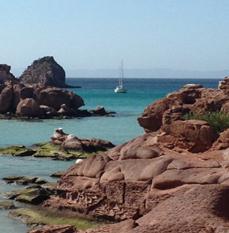 The next morning we headed for Los Islotes, the sea lion breeding ground. Los Islotes is a rock island where the sea lions make their home year round. We headed out there early as it is a very popular spot for tourist boats from La Paz. The objective was to swim with them! Jirig and I had our trepidations but Daniel and Nico were all in. There were hundreds of them. The big bull males can reach up to 800lbs and are easy to spot due to their size and a bone protrusion on their foreheads. The females are much smaller at about 200lbs. We were advised to stay
The next morning we headed for Los Islotes, the sea lion breeding ground. Los Islotes is a rock island where the sea lions make their home year round. We headed out there early as it is a very popular spot for tourist boats from La Paz. The objective was to swim with them! Jirig and I had our trepidations but Daniel and Nico were all in. There were hundreds of them. The big bull males can reach up to 800lbs and are easy to spot due to their size and a bone protrusion on their foreheads. The females are much smaller at about 200lbs. We were advised to stay  away from the males and to not do anything to appear aggressive towards them. There were many more females than bull males. The bulls mostly stayed on the rocky beach and bellowed to mark their territory. The females were another story altogether! They were very curious and immediately got in the water to swim with us. They swam right next to us, above us and below us. It was incredible! I had never been in the water with something so big and so close. There was a small passageway through 2 rock formations to the other side of the little island that had an arch forming above the water. We swam through the narrow passage with 3 females that stuck with us the whole time. It was like they were herding us through the passage. When we got to the other side of the island we saw a bunch of jellyfish so we immediately high tailed it back to the other side. The current was extremely strong and it was difficult to swim against it. Once we figured out that if you just ducked into a cove to get away from it we were fine. We snorkeled for about two hours until the tourist pangas started showing up. The wind was due to shift and start blowing at 10-15 knots out of the west so we headed to the other side of the island to get some protection. The east side of Espiritu Santo is very steep and jagged and there is only one good anchorage on that side, Punta Bonanza, so we headed there with our friends, Bill and Michelle, and their college aged daughters, Sarah and Jackie from Adagio. When we pulled around the point to the anchorage we were stunned! Before us was a huge protected cove with a 2 mile long white sand beach. This is why we are doing this. You can sail into a place so stunningly beautiful and we were the only boats there.
away from the males and to not do anything to appear aggressive towards them. There were many more females than bull males. The bulls mostly stayed on the rocky beach and bellowed to mark their territory. The females were another story altogether! They were very curious and immediately got in the water to swim with us. They swam right next to us, above us and below us. It was incredible! I had never been in the water with something so big and so close. There was a small passageway through 2 rock formations to the other side of the little island that had an arch forming above the water. We swam through the narrow passage with 3 females that stuck with us the whole time. It was like they were herding us through the passage. When we got to the other side of the island we saw a bunch of jellyfish so we immediately high tailed it back to the other side. The current was extremely strong and it was difficult to swim against it. Once we figured out that if you just ducked into a cove to get away from it we were fine. We snorkeled for about two hours until the tourist pangas started showing up. The wind was due to shift and start blowing at 10-15 knots out of the west so we headed to the other side of the island to get some protection. The east side of Espiritu Santo is very steep and jagged and there is only one good anchorage on that side, Punta Bonanza, so we headed there with our friends, Bill and Michelle, and their college aged daughters, Sarah and Jackie from Adagio. When we pulled around the point to the anchorage we were stunned! Before us was a huge protected cove with a 2 mile long white sand beach. This is why we are doing this. You can sail into a place so stunningly beautiful and we were the only boats there.
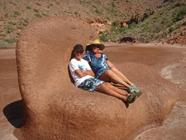 We all wanted to head to the beach. There was supposedly a trail that led to the other side of the island through the arroyo but we never found it. The kids decided they wanted to hike to the top of the 2200 ft. mountain, but Michelle and I quickly opted out of that. The kids, Daniel, Nico, Sarah and Jackie headed straight up the side of the mountain, right over the volcanic boulders to the top. Michelle and I returned to the beach to go shelling. The beach was covered
We all wanted to head to the beach. There was supposedly a trail that led to the other side of the island through the arroyo but we never found it. The kids decided they wanted to hike to the top of the 2200 ft. mountain, but Michelle and I quickly opted out of that. The kids, Daniel, Nico, Sarah and Jackie headed straight up the side of the mountain, right over the volcanic boulders to the top. Michelle and I returned to the beach to go shelling. The beach was covered  with them. Big beautiful ones and tiny, miniature ones. I have never been on a beach with so many shells. It was completely deserted, not even any footsteps in the sand. It was the perfect anchorage and we were totally protected from the wind from the west. It is unusual for the wind to blow from the west and you could see how rough this place could be in the prevailing northwest wind common this time of year. We pondered that maybe that was why there were so many shells on the beach? With the wind out of the northwest it had a good 200 miles for waves to build across the sea from mainland Mexico and that there would be some huge waves pummeling the beach. But we got lucky and we were there at the right time.
with them. Big beautiful ones and tiny, miniature ones. I have never been on a beach with so many shells. It was completely deserted, not even any footsteps in the sand. It was the perfect anchorage and we were totally protected from the wind from the west. It is unusual for the wind to blow from the west and you could see how rough this place could be in the prevailing northwest wind common this time of year. We pondered that maybe that was why there were so many shells on the beach? With the wind out of the northwest it had a good 200 miles for waves to build across the sea from mainland Mexico and that there would be some huge waves pummeling the beach. But we got lucky and we were there at the right time.
It is being able to discover places like this that is why we wanted to do this in the first place. It took a lot of work and determination to get here but it was worth it.
We love this cruising life!

![]() image003.emz
image003.emz
 Catalina) and are frequently visited by mariners staying in La Paz. They are a ‘must see’ if you are visiting the area.
Catalina) and are frequently visited by mariners staying in La Paz. They are a ‘must see’ if you are visiting the area.  and over to the other side of the island. Ensenada Ruiz did not have much in the way of a beach and it is covered with mangrove tress and their accompanying swamps. In Mexico, mangrove trees = mosquitos. Nico and I kayaked ashore but did not want to tramp through the mangroves to get to the other side. As you approach the trees you can hear all the buzzing from the bugs. No thank you! Nico and I are both bug wimps and mosquitos just love me. Each night we would do a potluck on someones boat. The ladies organize it so we have a balanced meal. We usually ate on the other boats as they are 55+ft power boats with much more room to entertain than we have. We would eat drink and play games. During the day we swam and snorkeled.
and over to the other side of the island. Ensenada Ruiz did not have much in the way of a beach and it is covered with mangrove tress and their accompanying swamps. In Mexico, mangrove trees = mosquitos. Nico and I kayaked ashore but did not want to tramp through the mangroves to get to the other side. As you approach the trees you can hear all the buzzing from the bugs. No thank you! Nico and I are both bug wimps and mosquitos just love me. Each night we would do a potluck on someones boat. The ladies organize it so we have a balanced meal. We usually ate on the other boats as they are 55+ft power boats with much more room to entertain than we have. We would eat drink and play games. During the day we swam and snorkeled.  It had a huge rock with a reef jutting out right in the middle of the cove so we were able to snorkel right from the boat. There is something so cool to me about being able to don your snorkel gear and just jump off the boat into this incredible marine wonderland. At first I was a little nervous because I was afraid of big fish and keep thinking that a shark would swim up and scare the
It had a huge rock with a reef jutting out right in the middle of the cove so we were able to snorkel right from the boat. There is something so cool to me about being able to don your snorkel gear and just jump off the boat into this incredible marine wonderland. At first I was a little nervous because I was afraid of big fish and keep thinking that a shark would swim up and scare the  shit out of me. But we did not see any sharks at all in the five days were out in the islands.
shit out of me. But we did not see any sharks at all in the five days were out in the islands. We headed back out to the islands on December 22. This time we were headed for Ensenada Grande. It is one of the most popular coves on the island. As soon as we got there in the late afternoon we jumped of the boat and swam to the reef to snorkel. Again the reef was right in the cove so no dingy was needed. The ancient, eroded volcanic ash cliff of the cove made for some spectacular scenery. The water was turquoise blue and was so clear that you could see our anchor set in the sand bottom, 60 feet down.
We headed back out to the islands on December 22. This time we were headed for Ensenada Grande. It is one of the most popular coves on the island. As soon as we got there in the late afternoon we jumped of the boat and swam to the reef to snorkel. Again the reef was right in the cove so no dingy was needed. The ancient, eroded volcanic ash cliff of the cove made for some spectacular scenery. The water was turquoise blue and was so clear that you could see our anchor set in the sand bottom, 60 feet down.  The next morning we headed for Los Islotes, the sea lion breeding ground. Los Islotes is a rock island where the sea lions make their home year round. We headed out there early as it is a very popular spot for tourist boats from La Paz. The objective was to swim with them! Jirig and I had our trepidations but Daniel and Nico were all in. There were hundreds of them. The big bull males can reach up to 800lbs and are easy to spot due to their size and a bone protrusion on their foreheads. The females are much smaller at about 200lbs. We were advised to stay
The next morning we headed for Los Islotes, the sea lion breeding ground. Los Islotes is a rock island where the sea lions make their home year round. We headed out there early as it is a very popular spot for tourist boats from La Paz. The objective was to swim with them! Jirig and I had our trepidations but Daniel and Nico were all in. There were hundreds of them. The big bull males can reach up to 800lbs and are easy to spot due to their size and a bone protrusion on their foreheads. The females are much smaller at about 200lbs. We were advised to stay  away from the males and to not do anything to appear aggressive towards them. There were many more females than bull males. The bulls mostly stayed on the rocky beach and bellowed to mark their territory. The females were another story altogether! They were very curious and immediately got in the water to swim with us. They swam right next to us, above us and below us. It was incredible! I had never been in the water with something so big and so close. There was a small passageway through 2 rock formations to the other side of the little island that had an arch forming above the water. We swam through the narrow passage with 3 females that stuck with us the whole time. It was like they were herding us through the passage. When we got to the other side of the island we saw a bunch of jellyfish so we immediately high tailed it back to the other side. The current was extremely strong and it was difficult to swim against it. Once we figured out that if you just ducked into a cove to get away from it we were fine. We snorkeled for about two hours until the tourist pangas started showing up. The wind was due to shift and start blowing at 10-15 knots out of the west so we headed to the other side of the island to get some protection. The east side of Espiritu Santo is very steep and jagged and there is only one good anchorage on that side, Punta Bonanza, so we headed there with our friends, Bill and Michelle, and their college aged daughters, Sarah and Jackie from Adagio. When we pulled around the point to the anchorage we were stunned! Before us was a huge protected cove with a 2 mile long white sand beach. This is why we are doing this. You can sail into a place so stunningly beautiful and we were the only boats there.
away from the males and to not do anything to appear aggressive towards them. There were many more females than bull males. The bulls mostly stayed on the rocky beach and bellowed to mark their territory. The females were another story altogether! They were very curious and immediately got in the water to swim with us. They swam right next to us, above us and below us. It was incredible! I had never been in the water with something so big and so close. There was a small passageway through 2 rock formations to the other side of the little island that had an arch forming above the water. We swam through the narrow passage with 3 females that stuck with us the whole time. It was like they were herding us through the passage. When we got to the other side of the island we saw a bunch of jellyfish so we immediately high tailed it back to the other side. The current was extremely strong and it was difficult to swim against it. Once we figured out that if you just ducked into a cove to get away from it we were fine. We snorkeled for about two hours until the tourist pangas started showing up. The wind was due to shift and start blowing at 10-15 knots out of the west so we headed to the other side of the island to get some protection. The east side of Espiritu Santo is very steep and jagged and there is only one good anchorage on that side, Punta Bonanza, so we headed there with our friends, Bill and Michelle, and their college aged daughters, Sarah and Jackie from Adagio. When we pulled around the point to the anchorage we were stunned! Before us was a huge protected cove with a 2 mile long white sand beach. This is why we are doing this. You can sail into a place so stunningly beautiful and we were the only boats there.  We all wanted to head to the beach. There was supposedly a trail that led to the other side of the island through the arroyo but we never found it. The kids decided they wanted to hike to the top of the 2200 ft. mountain, but Michelle and I quickly opted out of that. The kids, Daniel, Nico, Sarah and Jackie headed straight up the side of the mountain, right over the volcanic boulders to the top. Michelle and I returned to the beach to go shelling. The beach was covered
We all wanted to head to the beach. There was supposedly a trail that led to the other side of the island through the arroyo but we never found it. The kids decided they wanted to hike to the top of the 2200 ft. mountain, but Michelle and I quickly opted out of that. The kids, Daniel, Nico, Sarah and Jackie headed straight up the side of the mountain, right over the volcanic boulders to the top. Michelle and I returned to the beach to go shelling. The beach was covered  with them. Big beautiful ones and tiny, miniature ones. I have never been on a beach with so many shells. It was completely deserted, not even any footsteps in the sand. It was the perfect anchorage and we were totally protected from the wind from the west. It is unusual for the wind to blow from the west and you could see how rough this place could be in the prevailing northwest wind common this time of year. We pondered that maybe that was why there were so many shells on the beach? With the wind out of the northwest it had a good 200 miles for waves to build across the sea from mainland Mexico and that there would be some huge waves pummeling the beach. But we got lucky and we were there at the right time.
with them. Big beautiful ones and tiny, miniature ones. I have never been on a beach with so many shells. It was completely deserted, not even any footsteps in the sand. It was the perfect anchorage and we were totally protected from the wind from the west. It is unusual for the wind to blow from the west and you could see how rough this place could be in the prevailing northwest wind common this time of year. We pondered that maybe that was why there were so many shells on the beach? With the wind out of the northwest it had a good 200 miles for waves to build across the sea from mainland Mexico and that there would be some huge waves pummeling the beach. But we got lucky and we were there at the right time. 

